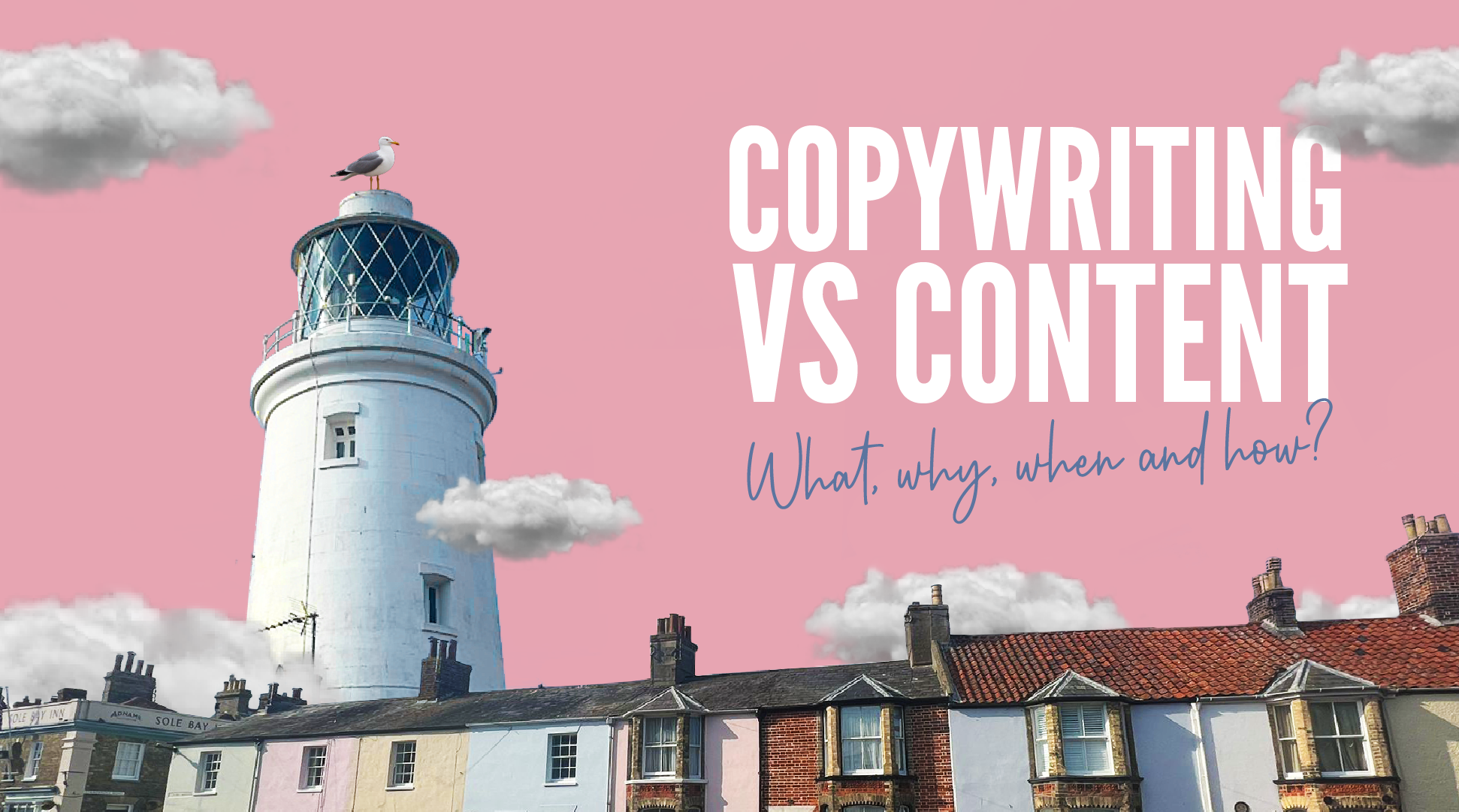
Copywriting Vs Content Writing
BY Richard Revell | Journal | 15/06/2023

Copywriting and content writing are two terms that are often used interchangeably, but is that accurate? In this article, we’re going to look at the two types of writing, delving deep into what they are, what their purpose is and – most importantly – how you can get the most benefit from them.
The definition of copywriting
Let’s start with copywriting. As with most things the definition varies slightly from person to person, but the general consensus is that copywriting is writing which aims to convince the reader to take a specific action. The obvious example is making a purchase, but it could also be signing up to a newsletter, calling a phone number or adopting a granny.
From there you can split copywriting into direct-response copy and indirect response copy.
The first is the there and then, in the moment-ness of the ‘buy now’ link, the ‘start your free trial’ button, the ‘call us today’ flash. That’s direct response – it’s instant, measurable and easy to test, refine and test again.
On the other hand, indirect response copy gets your attention briefly, but its main purpose is to drop awareness of the product, Derren Brown style, into your back brain, in the hope that it lingers there long enough to leap out at you when it comes to making a buying choice. At first glance this doesn’t seem as effective, but it’s where the big brands flourish – when was the last time you saw a McDonald’s ad saying go and buy a Big Mac? Instead, we’re told that Beanz meanz Heinz, and we should Believe in better.
The importance of good copywriting
If you want to sell something then you need good copywriting. An image or a video may grab the attention of your audience, but it’s the writing that will keep your reader engaged and get them to take the desired action. Done properly, it will also help build your brand, and – in the case of website copywriting – improve SEO.
Different types of copywriting
Copywriting takes many shapes, from twenty-page letters to a few words on a website button. And while the principles and the goals remain the same, the techniques need to be adapted for the format.
Long form
As the name suggests, this is copywriting that uses up a lot of ink (or requires plenty of scrolling). It could be a letter, a pack, a presentation or promotion, but whatever the medium, this is marketing where you have the room to deliver all your points, demonstrate every benefit and drop in all your bonuses.
For anyone who rails against word limits this sounds like writing heaven, but it takes great skill, planning, understanding and a whole lot of rewrites to keep your reader engaged from salutation to sign off. And counterintuitively there’s no room for fluff – every word must work.
Email
Generally copywriting in email form is the introducer. The only action you want the reader to take is to click through to the webpage where your long form copywriting sits, which is often known as a:
Landing Page
This is the part of your website where you convert interest into action. It has a grabby headline, cleverly written calls to action throughout, and all the content works together to convince the reader to make the desired move.
Adverts
Probably the most obvious form of copywriting. Whether it’s a TV commercial, a jingle on the radio, that twenty second slot that interrupts your YouTube video, or a few words around a picture on your social media feed, behind them all is a copywriter. (Whether they’re good or not is a different matter.)

Techniques for effective copywriting
Have. An. Idea.
Every piece of copywriting you do needs an idea behind it. It’s not enough to just list the features of your product or service. Even showing the benefits won’t do it. The idea is the heart of what will make your copywriting work and you should never lose sight of it.
Keep it moving
From the headline to the final call to action, and all the subheadings, quotes, links, line breaks and normal text in between, everything should work together to take the reader on a smooth ride of persuasion. Getting them from first word to the final click without hindrance is your goal.
Have a structure
Copywriting is an art. But it’s also a science, built on psychology. Over the years various marketing, advertising, branding and copywriting experts have defined different formulas they absolutely guarantee will have people falling over themselves to buy your product. There’s AIDA (Attention, Interest, Desire, Action), PADS (Problem, Agitation, Discredit, Solution), SPIN (Situation, Problem, Implication, Need) and even HELLYEAH (Holler, Empathise, Lambast, Legwork, Yes, Educate, Action, Handle). And that’s just scratching the surface. A quick internet search will bring up dozens of formulas and enough tortured acronyms to make even the military jealous.
Stay focused, stay brutal
Never lose track that you’re presenting an idea to a person to persuade them to take an action. There is almost always a temptation to get too clever – we’re copywriters after all, bright people. But if that genius subheading or perfectly crafted analogy about the owl wearing a hat obscures the idea, then it’s got to go, no matter how much you love it.
Don’t write to an audience
I know, I know. Obviously it’s really important to know the group of people you’re trying to sell to. But unless you know for certain they’re going to read it as a group (and I can guarantee you here and now that they won’t) you should have one person in mind when you’re writing.
Question everything
You can’t sell what you don’t know. So you’d better make sure you know everything about it. Its features. The usp. The pain points it solves. What customers think about it, what colours it comes in, how much it weighs, what it smells like, the anecdotes about its creation, where the name came from – you get the idea. Ask as many questions as you can, and if you’re still struggling to write authentically, ask some more.
The role of AI in copywriting
Setting aside the fact that the term ‘AI’ is a clever bit of copywriting in itself (it sounds so much more exciting than ‘algorithm’), there’s a lot of speculation around whether AI will replace copywriters. Short answer is, it won’t. No more than Canva has replaced designers, or Logic has wiped out session musicians. AI has no creativity, no imagination, no ability to draw together an understanding of all the different factors that effective copywriting needs.
It is a useful tool for a copywriter though, great for doing things like getting over the blank page syndrome, pulling together facts and generating (very) rough first drafts. There’s also a heap of untapped potential there. But the bottom line is, if you ask a robot to write your copy, don’t be surprised if you get robotic copy. Or that your competitors start outselling you.
That’s a whistle-stop look at copywriting, in our next article we’ll put content writing under the microscope. Make sure you follow us on social to know when it’s out.



